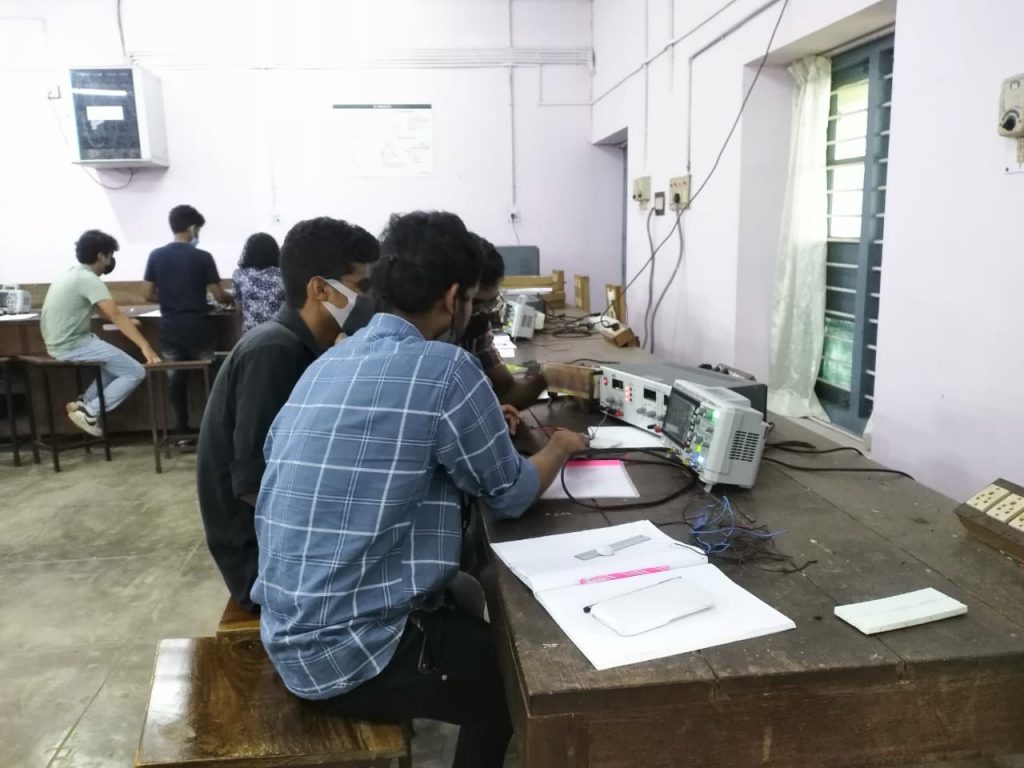
Lab in charge:
- Faculty: Prof. Rencymol M V
- Technical Staff: Mr. Udayakumar T S
Details of Labs conducted:
- ECL331 – ANALOG INTEGRATED CIRCUITS & SIMULATION LAB – S5 ECE
- AEL331 – ANALOG INTEGRATED CIRCUITS & INSTRUMENTATION LAB – S5 AEI
- ECL332 – COMMUNICATION LAB – S6 ECE
ECL331 – ANALOG INTEGRATED CIRCUITS & SIMULATION LAB
This course aims to:
- Familiarize students with the Analog Integrated Circuits and Design and implementation of application circuits using basic Analog Integrated Circuits
- Familiarize students with simulation of basic Analog Integrated Circuits.
LIST OF EXPERIMENTS:
I. Fundamentals of operational amplifiers and basic circuits
[Minimum seven experiments are to be done]
1 Familiarization of Operational amplifiers – Inverting and Non inverting amplifiers, frequency response, Adder, Integrator, Comparators.
2 Measurement of Op-Amp parameters.
3 Difference Amplifier and Instrumentation amplifier.
4 Schmitt trigger circuit using Op–Amps.
5 Astable and Monostable multivibrator using Op-Amps.
6 Waveform generators using Op-Amps – Triangular and saw tooth
7 Wien bridge oscillator using Op-Amp – without & with amplitude stabilization.
8 RC Phase shift Oscillator.
9 Active second order filters using Op-Amp (LPF, HPF, BPF and BSF).
10 Notch filters to eliminate the 50Hz power line frequency.
11 Precision rectifiers using Op-Amp.
II. Application circuits of 555 Timer/565 PLL/ Regulator(IC 723) ICs
[ Minimum three experiments are to be done]
1 Astable and Monostable multivibrator using Timer IC NE555
2 DC power supply using IC 723: Low voltage and high voltage configurations, Short circuit and Fold-back protection.
3 A/D converters- counter ramp and flash type
4 D/A Converters – R-2R ladder circuit
5 Study of PLL IC: free running frequency lock range capture range
III. Simulation experiments [The experiments shall be conducted using SPICE]
1 Simulation of any three circuits from Experiments 3, 5, 6, 7, 8, 9, 10 and 11 of section I
2 Simulation of Experiments 3 or 4 from section II
AEL331 – ANALOG INTEGRATED CIRCUITS & INSTRUMENTATION LAB
This course aims to:
- To develop skills in designing and testing analog integrated circuits
- Expose the students to a variety of practical circuits using various analog ICs
LIST OF EXPERIMENTS:
Part A – Analog Integrated Circuits Lab (At least 8 experiments are mandatory)
1. Design and plot the frequency response of i) Inverting and Non inverting amplifiers ii) Differentiator and Integrator.
2. Design of Adder circuits.
3. Measurement of Opamp parameters.
4. Difference Amplifier and Instrumentation amplifier
5. Schmitt trigger circuit using Op –Amps.
6. Astable and Monostable multivibrator using Op -Amps.
7. Triangular and square wave generators using Op- Amps.
8. RC Phase shift Oscillator using Op-Amps
9. Wien bridge oscillator using Op-Amp – without & with amplitude stabilization.
10. Active second order filters using Op-Amp (LPF, HPF, BPF and BSF).
11. Notch filters to eliminate the 50Hz power line frequency.
12. Astable and Monostable multivibrator using Timer IC NE555.
13. IC voltage regulators.
14 A/D converters – Flash type.
15 D/A Converters-R-2R ladder circuit.
16 Study of PLL IC: free running frequency lock range capture range
ECL332 – COMMUNICATION LAB
LIST OF EXPERIMENTS:
PART A
Any two experiments are mandatory. The students shall design and setup simple prototype circuits with the help of available ICs. They can observe Waveforms produced by these circuits for standard ideal inputs.
1. FM generation and demodulation using PLL
2. Generation and Detection of PCM signals
3. Generation and Detection of Delta modulated signals
4. Generation and Detection of BPSK
5. Generation and Detection of 16-QPSK
PART B
All experiments are mandatory. The students shall write scripts to simulate components of communication systems. They shall plot various graphs that help to appreciate and compare performance.
- Performance of Waveform Coding Using PCM
- Pulse Shaping and Matched Filtering
- Eye Diagram
- Error Performance of BPSK
- Error Performance of QPSK
PART C
Any two experiments are mandatory. The students shall emulate communication systems with the help of software-defined-radio hardware and necessary control software. Use available blocks in GNU Radio to implement all the signal processing. These experiments will help students to appreciate better how theoretical concepts are translated into practice.
1. Familiarization with Software Defined Radio (Hardware and Control Software)
2. FM Reception
3. FM Transmission
